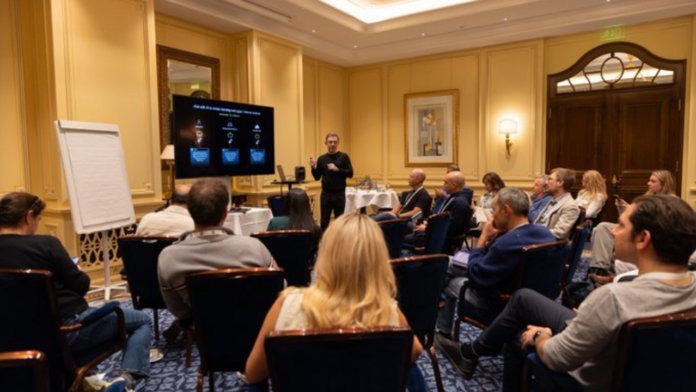Dominic Williams took the stage at CfC St. Moritz 2025, presenting bold ideas about where blockchain and AI are headed. Speaking alongside Kerri Langlais, Leemon Baird, Olivier François, and David Johnston, he outlined two key focus areas: running AI models as smart contracts and building a self-writing, sovereign internet.
The discussion touched on how AI could automate processes within blockchain networks, allowing applications to function with minimal human input. While smart contracts have already transformed finance and governance, integrating AI could take automation to an entirely new level. This raises questions about whether future applications will be designed, updated, and maintained without developers writing every line of code.
A standout moment came when Williams unveiled a live demo of Caffeine AI, marking a first for the Internet Computer community. Though details were limited, the demonstration hinted at a future where AI models operate directly on-chain, unlocking new possibilities for automation. If this approach proves viable, it could remove reliance on centralised services, shifting more computational processes onto blockchain networks.
CfC St. Moritz has always been a hotspot for discussing emerging trends, and the combination of AI and blockchain is generating plenty of debate. Williams has long pushed for a fully decentralised web, and his latest vision aligns with that goal. By reducing dependence on traditional infrastructure, developers could create applications that run independently, without relying on external hosting providers.
The potential of AI-powered smart contracts is vast, but challenges remain. Running AI models within blockchain environments presents issues around cost, security, and processing power. Despite this, Williams remains confident that the benefits outweigh the obstacles. A system where AI handles much of the heavy lifting could make blockchain more accessible, reducing the technical barriers that prevent wider adoption.
Beyond the panel discussions, CfC St. Moritz provided plenty of opportunities for conversations about what comes next. Companies are increasingly exploring how AI and blockchain can work together, whether for financial systems, automated governance, or entirely new types of applications. If AI-generated smart contracts become a reality, they could change the way software evolves, shifting control away from centralised entities and towards decentralised networks.
Williams’ idea of a self-writing internet suggests a shift towards software that updates itself, removing the need for manual intervention. While this concept has its critics, the idea of AI-driven development is gaining traction. Security and ethical considerations will play a major role in shaping how this technology is used, but the fact that these conversations are happening at events like CfC St. Moritz shows that the industry is taking it seriously.
As AI and blockchain continue to merge, the impact could be far-reaching. Whether Williams’ predictions come to pass remains to be seen, but one thing is clear—this is just the beginning of a much bigger shift in how technology is built and maintained.


